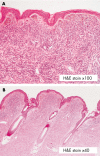Gene expression profiles of giant hairy naevi
- PMID: 15280407
- PMCID: PMC1770402
- DOI: 10.1136/jcp.2003.014274
Gene expression profiles of giant hairy naevi
Abstract
Background: Congenital neomelanocytic naevi appear in nearly 1% of newborns. Giant hairy naevi (GHN) are uncommon lesions covering large areas of the body. They are of concern because they have the potential to transform into malignant melanomas.
Aims: To describe gene expression profiles of GHN and nearby normal skin from patients with GHN and normal control skin (from patients with cleft lip/palate).
Methods: Tissues from three patients with GHN and two normal controls were studied for differences in gene expression profiles. Total RNA was isolated from normal skin near the hairy naevus, GHN, and skin from normal controls. The RNA samples were subjected to probe labelling, hybridisation to chips, and image acquisition according to the standard Affymetrix protocol.
Results: There were 227 genes affected across all samples, as determined by DNA microarray analysis. There was increased expression of 22 genes in GHN compared with nearby normal skin. Decreased expression was noted in 73 genes. In addition, there was increased expression of 36 genes in normal skin near GHN compared with normal control skin, and decreased expression of five genes. Categories of genes affected were those encoding structural proteins, proteins related to developmental processes, cell death associated proteins, transcription factors, growth factors, stress response modulators, and collagen associated proteins. Changes in mRNA expression were checked by reverse transcription polymerase chain reaction.
Conclusions: Genetic profiles of GHN may provide insight into their pathogenesis, including their potential for malignant transformation. Such information may be useful in improving the understanding and management of these lesions.
Figures


References
-
- Penman HG, Stringer HC. Malignant transformation in giant congenital pigmented nevus. Death in early childhood. Arch Dermatol 1971;103:428–32. - PubMed
-
- Kopf AW, Bart RS, Hennessey P. Congenital nevocytic nevi and malignant melanomas. J Am Acad Dermatol 1979;1:123–30. - PubMed
-
- Jerdan MS, Cohen BA, Smith RR, et al. Neuroectodermal neoplasms arising in congenital nevi. Am J Dermatopathol 1985;7 (suppl) :41–8. - PubMed
-
- Block LI, Conway H. Giant nevus of face and neck—excision and skin grafting. Plast Reconstr Surg 1963;31:472–7. - PubMed
-
- Russell JL, Reyes RG. Giant pigmented nevi. JAMA 1959;171:2083–6. - PubMed
Publication types
MeSH terms
Grants and funding
LinkOut - more resources
Full Text Sources
Medical
